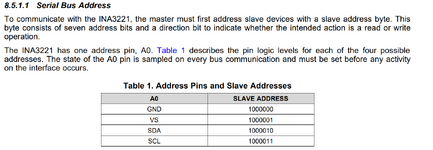engr_joni_ee
Advanced Member level 3

I am working with adding INA3221 in my schematic. I am wondering about the address pin. There is only one address pin Ao. The pin Ao can be attached to GND, VS, SDA, or SCL. Does it means only four devices INA3221 can be attached to I2C bus ?
The slave addresses (7 bits) mentioned in Table 1 in the datasheet has only four different addresses which corresponds to four Ao connection options.
Question: How can we add six INA3221 to I2C ?
The slave addresses (7 bits) mentioned in Table 1 in the datasheet has only four different addresses which corresponds to four Ao connection options.
Question: How can we add six INA3221 to I2C ?



